300886 Construction in Practice: Lightweight Roofing Systems Report
VerifiedAdded on 2022/09/17
|12
|2449
|16
Report
AI Summary
This report provides a comprehensive analysis of lightweight, energy-efficient roofing systems for residential buildings, fulfilling the requirements of the Construction in Practice assignment. It delves into three distinct roofing systems: metal roofing, composite shingle roofing, and skylight membrane roofing. The report meticulously outlines the advantages and disadvantages of each system, encompassing factors such as durability, cost-effectiveness, ease of installation, and environmental impact. The study also explores the energy efficiency aspects, highlighting how each system contributes to reducing energy consumption and heat transfer. Furthermore, the report includes a comparative cost analysis of the three roofing systems, considering installation expenses. The conclusion emphasizes the importance of selecting an appropriate roofing system to optimize a building's environmental performance, focusing on lightweight and energy-efficient solutions for sustainable construction practices. The report is well-structured, including an introduction, detailed sections for each roofing system, a cost comparison, and a conclusion, supported by relevant references.
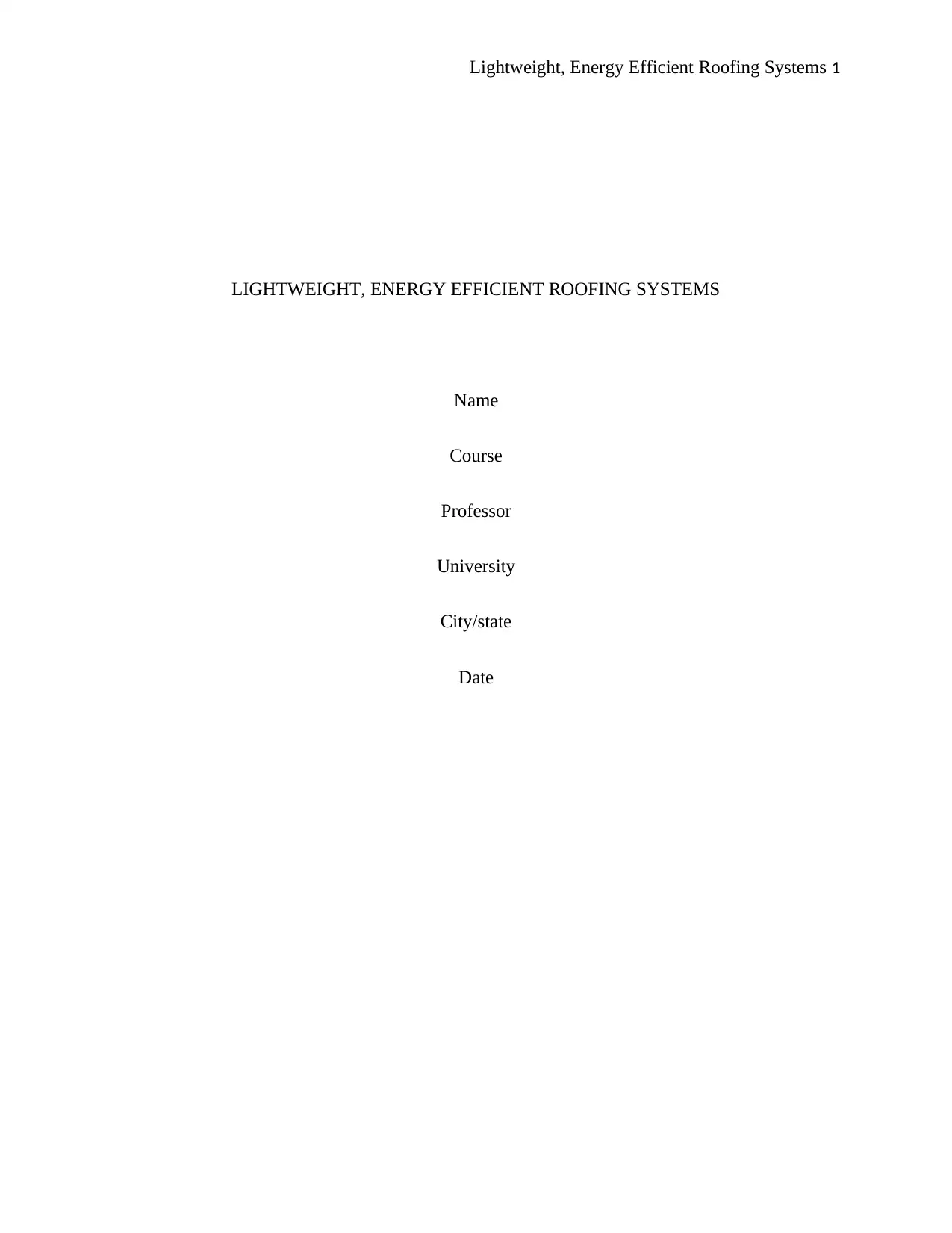
Lightweight, Energy Efficient Roofing Systems 1
LIGHTWEIGHT, ENERGY EFFICIENT ROOFING SYSTEMS
Name
Course
Professor
University
City/state
Date
LIGHTWEIGHT, ENERGY EFFICIENT ROOFING SYSTEMS
Name
Course
Professor
University
City/state
Date
Paraphrase This Document
Need a fresh take? Get an instant paraphrase of this document with our AI Paraphraser
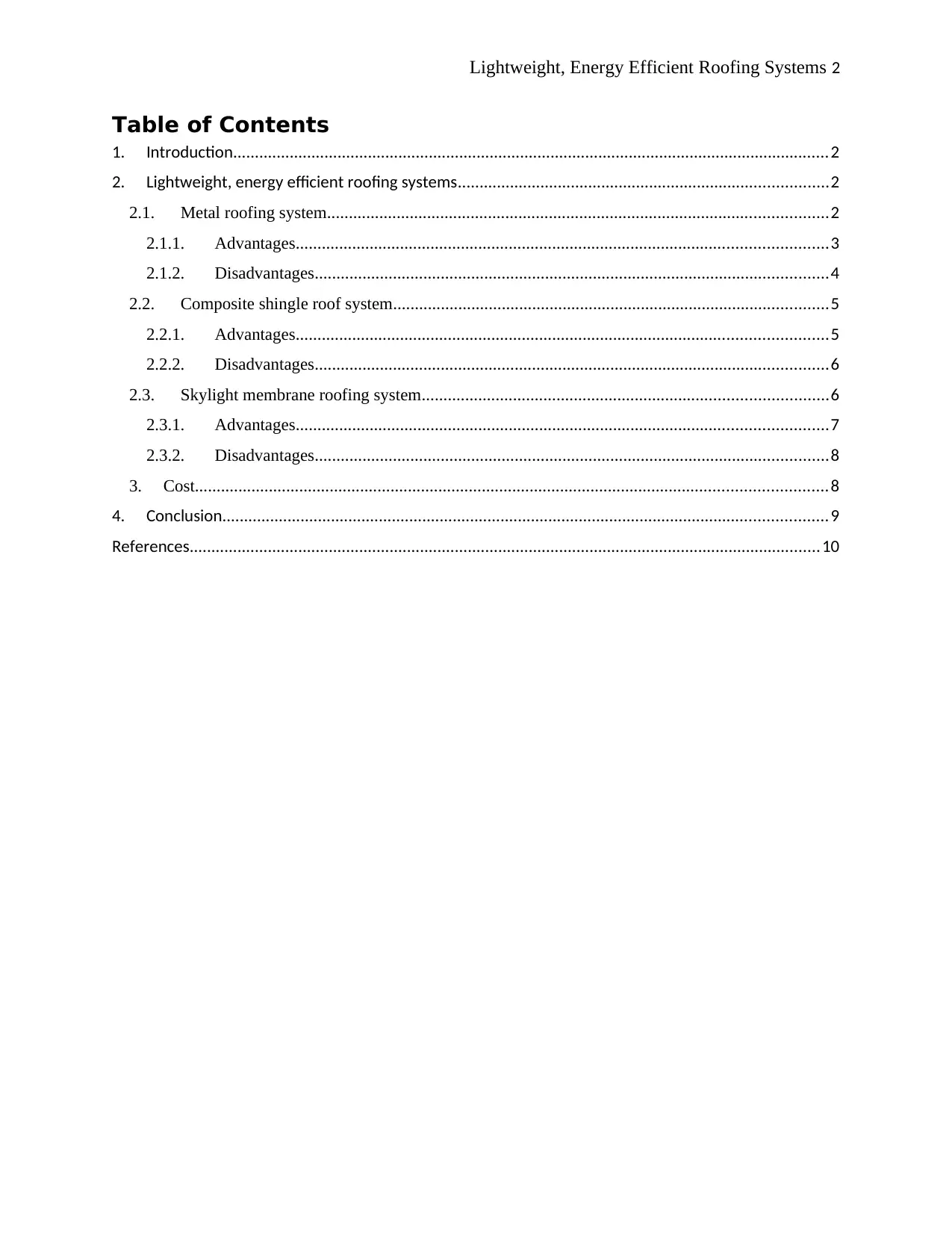
Lightweight, Energy Efficient Roofing Systems 2
Table of Contents
1. Introduction.........................................................................................................................................2
2. Lightweight, energy efficient roofing systems.....................................................................................2
2.1. Metal roofing system...................................................................................................................2
2.1.1. Advantages..........................................................................................................................3
2.1.2. Disadvantages......................................................................................................................4
2.2. Composite shingle roof system....................................................................................................5
2.2.1. Advantages..........................................................................................................................5
2.2.2. Disadvantages......................................................................................................................6
2.3. Skylight membrane roofing system.............................................................................................6
2.3.1. Advantages..........................................................................................................................7
2.3.2. Disadvantages......................................................................................................................8
3. Cost.................................................................................................................................................8
4. Conclusion...........................................................................................................................................9
References.................................................................................................................................................10
Table of Contents
1. Introduction.........................................................................................................................................2
2. Lightweight, energy efficient roofing systems.....................................................................................2
2.1. Metal roofing system...................................................................................................................2
2.1.1. Advantages..........................................................................................................................3
2.1.2. Disadvantages......................................................................................................................4
2.2. Composite shingle roof system....................................................................................................5
2.2.1. Advantages..........................................................................................................................5
2.2.2. Disadvantages......................................................................................................................6
2.3. Skylight membrane roofing system.............................................................................................6
2.3.1. Advantages..........................................................................................................................7
2.3.2. Disadvantages......................................................................................................................8
3. Cost.................................................................................................................................................8
4. Conclusion...........................................................................................................................................9
References.................................................................................................................................................10
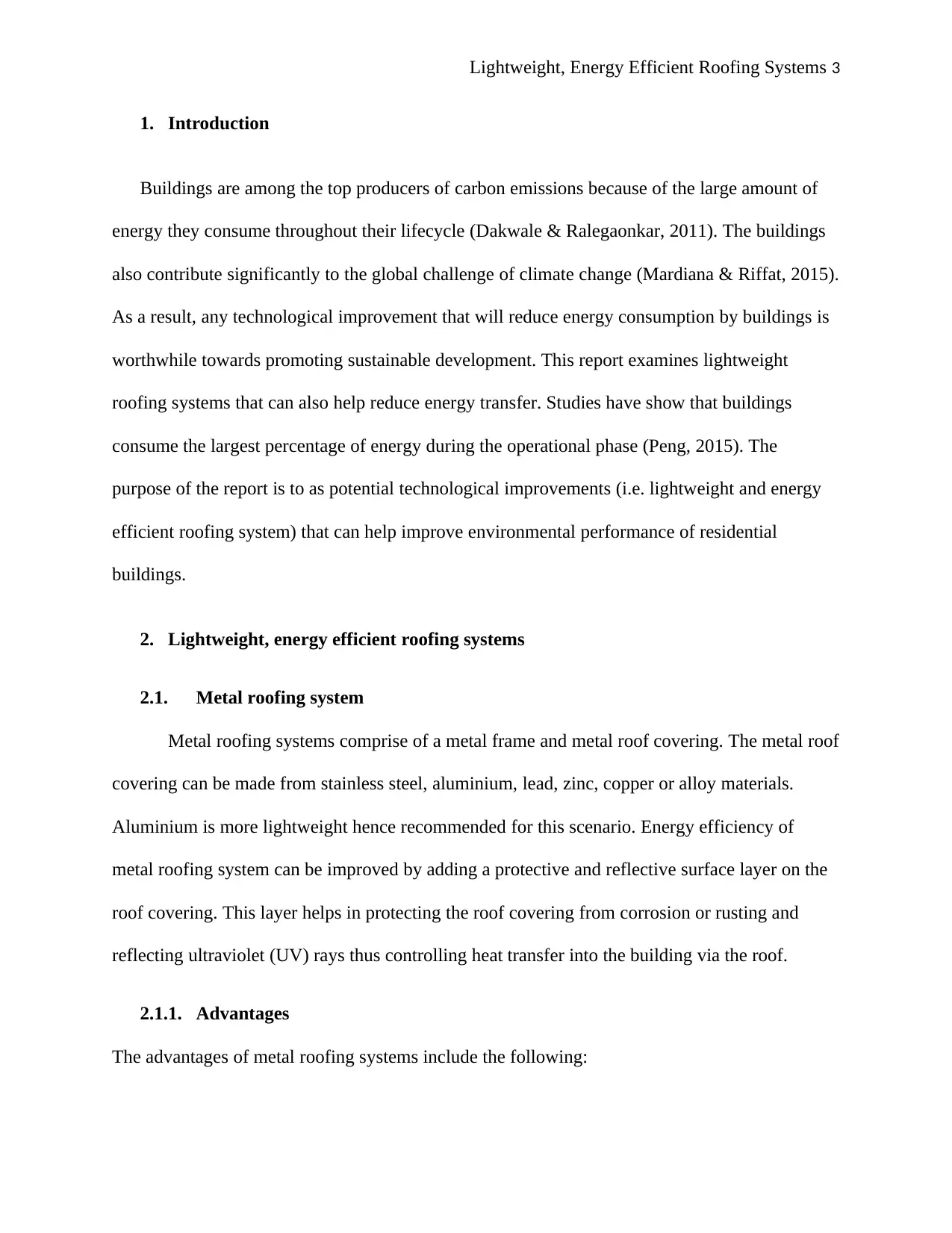
Lightweight, Energy Efficient Roofing Systems 3
1. Introduction
Buildings are among the top producers of carbon emissions because of the large amount of
energy they consume throughout their lifecycle (Dakwale & Ralegaonkar, 2011). The buildings
also contribute significantly to the global challenge of climate change (Mardiana & Riffat, 2015).
As a result, any technological improvement that will reduce energy consumption by buildings is
worthwhile towards promoting sustainable development. This report examines lightweight
roofing systems that can also help reduce energy transfer. Studies have show that buildings
consume the largest percentage of energy during the operational phase (Peng, 2015). The
purpose of the report is to as potential technological improvements (i.e. lightweight and energy
efficient roofing system) that can help improve environmental performance of residential
buildings.
2. Lightweight, energy efficient roofing systems
2.1. Metal roofing system
Metal roofing systems comprise of a metal frame and metal roof covering. The metal roof
covering can be made from stainless steel, aluminium, lead, zinc, copper or alloy materials.
Aluminium is more lightweight hence recommended for this scenario. Energy efficiency of
metal roofing system can be improved by adding a protective and reflective surface layer on the
roof covering. This layer helps in protecting the roof covering from corrosion or rusting and
reflecting ultraviolet (UV) rays thus controlling heat transfer into the building via the roof.
2.1.1. Advantages
The advantages of metal roofing systems include the following:
1. Introduction
Buildings are among the top producers of carbon emissions because of the large amount of
energy they consume throughout their lifecycle (Dakwale & Ralegaonkar, 2011). The buildings
also contribute significantly to the global challenge of climate change (Mardiana & Riffat, 2015).
As a result, any technological improvement that will reduce energy consumption by buildings is
worthwhile towards promoting sustainable development. This report examines lightweight
roofing systems that can also help reduce energy transfer. Studies have show that buildings
consume the largest percentage of energy during the operational phase (Peng, 2015). The
purpose of the report is to as potential technological improvements (i.e. lightweight and energy
efficient roofing system) that can help improve environmental performance of residential
buildings.
2. Lightweight, energy efficient roofing systems
2.1. Metal roofing system
Metal roofing systems comprise of a metal frame and metal roof covering. The metal roof
covering can be made from stainless steel, aluminium, lead, zinc, copper or alloy materials.
Aluminium is more lightweight hence recommended for this scenario. Energy efficiency of
metal roofing system can be improved by adding a protective and reflective surface layer on the
roof covering. This layer helps in protecting the roof covering from corrosion or rusting and
reflecting ultraviolet (UV) rays thus controlling heat transfer into the building via the roof.
2.1.1. Advantages
The advantages of metal roofing systems include the following:
⊘ This is a preview!⊘
Do you want full access?
Subscribe today to unlock all pages.

Trusted by 1+ million students worldwide
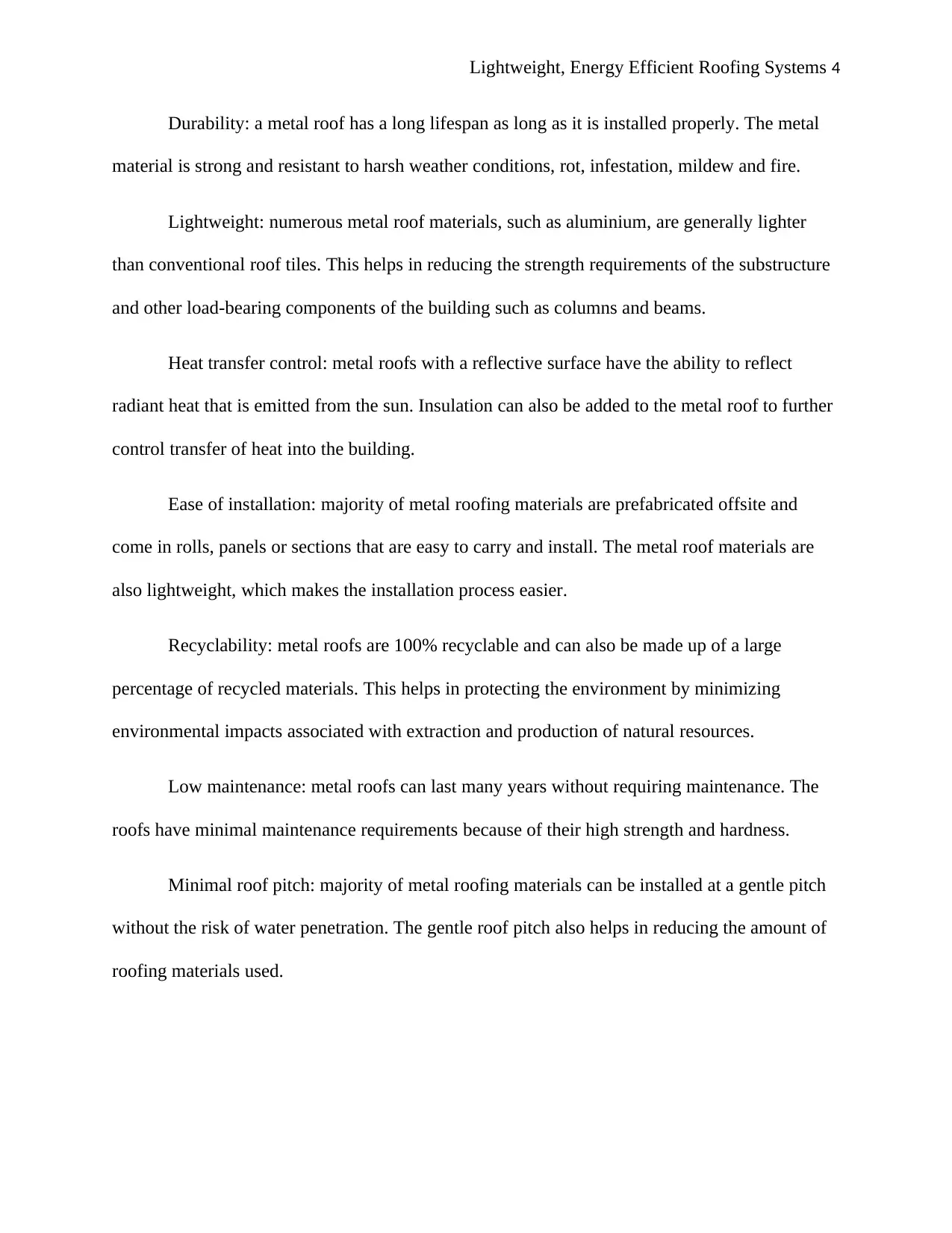
Lightweight, Energy Efficient Roofing Systems 4
Durability: a metal roof has a long lifespan as long as it is installed properly. The metal
material is strong and resistant to harsh weather conditions, rot, infestation, mildew and fire.
Lightweight: numerous metal roof materials, such as aluminium, are generally lighter
than conventional roof tiles. This helps in reducing the strength requirements of the substructure
and other load-bearing components of the building such as columns and beams.
Heat transfer control: metal roofs with a reflective surface have the ability to reflect
radiant heat that is emitted from the sun. Insulation can also be added to the metal roof to further
control transfer of heat into the building.
Ease of installation: majority of metal roofing materials are prefabricated offsite and
come in rolls, panels or sections that are easy to carry and install. The metal roof materials are
also lightweight, which makes the installation process easier.
Recyclability: metal roofs are 100% recyclable and can also be made up of a large
percentage of recycled materials. This helps in protecting the environment by minimizing
environmental impacts associated with extraction and production of natural resources.
Low maintenance: metal roofs can last many years without requiring maintenance. The
roofs have minimal maintenance requirements because of their high strength and hardness.
Minimal roof pitch: majority of metal roofing materials can be installed at a gentle pitch
without the risk of water penetration. The gentle roof pitch also helps in reducing the amount of
roofing materials used.
Durability: a metal roof has a long lifespan as long as it is installed properly. The metal
material is strong and resistant to harsh weather conditions, rot, infestation, mildew and fire.
Lightweight: numerous metal roof materials, such as aluminium, are generally lighter
than conventional roof tiles. This helps in reducing the strength requirements of the substructure
and other load-bearing components of the building such as columns and beams.
Heat transfer control: metal roofs with a reflective surface have the ability to reflect
radiant heat that is emitted from the sun. Insulation can also be added to the metal roof to further
control transfer of heat into the building.
Ease of installation: majority of metal roofing materials are prefabricated offsite and
come in rolls, panels or sections that are easy to carry and install. The metal roof materials are
also lightweight, which makes the installation process easier.
Recyclability: metal roofs are 100% recyclable and can also be made up of a large
percentage of recycled materials. This helps in protecting the environment by minimizing
environmental impacts associated with extraction and production of natural resources.
Low maintenance: metal roofs can last many years without requiring maintenance. The
roofs have minimal maintenance requirements because of their high strength and hardness.
Minimal roof pitch: majority of metal roofing materials can be installed at a gentle pitch
without the risk of water penetration. The gentle roof pitch also helps in reducing the amount of
roofing materials used.
Paraphrase This Document
Need a fresh take? Get an instant paraphrase of this document with our AI Paraphraser
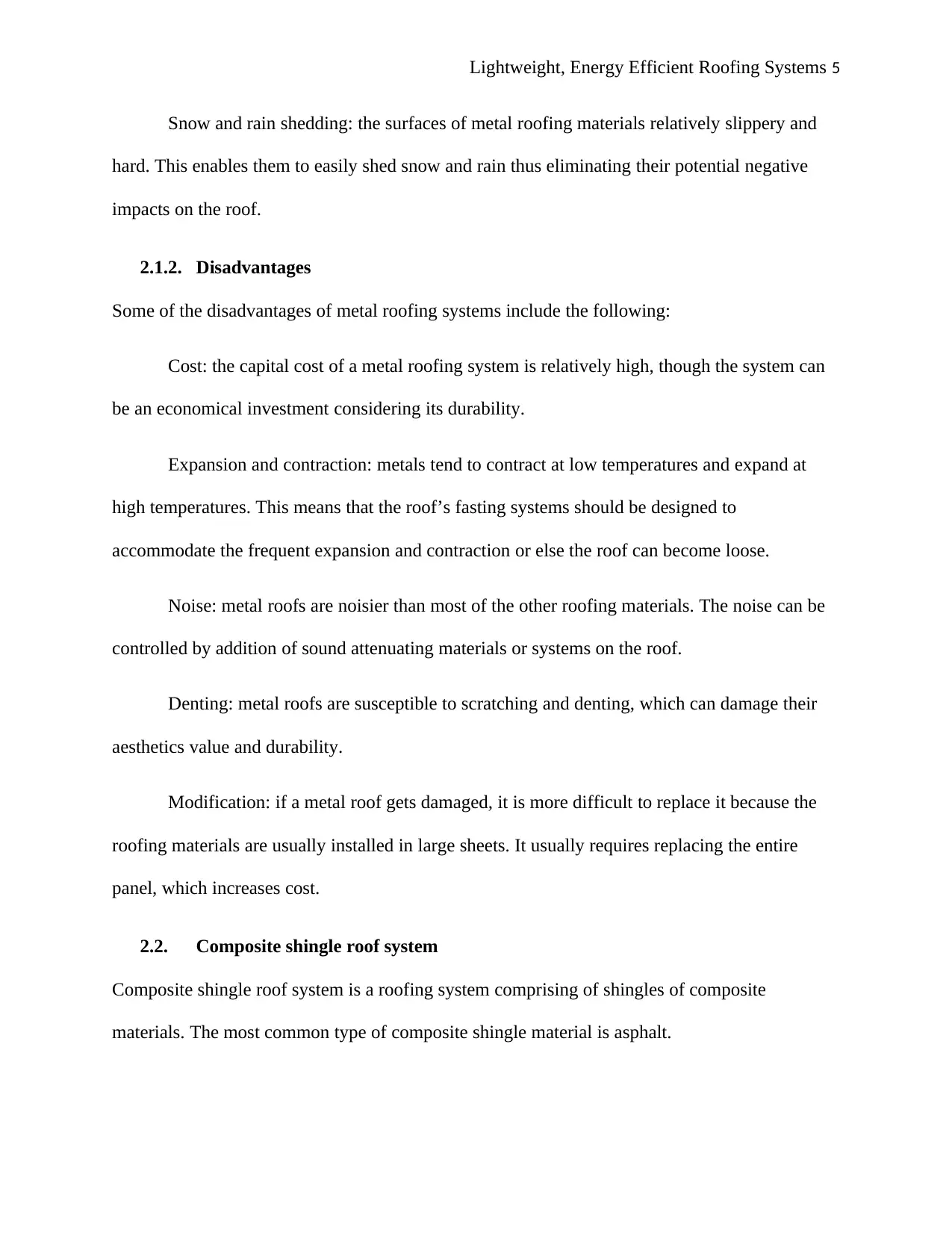
Lightweight, Energy Efficient Roofing Systems 5
Snow and rain shedding: the surfaces of metal roofing materials relatively slippery and
hard. This enables them to easily shed snow and rain thus eliminating their potential negative
impacts on the roof.
2.1.2. Disadvantages
Some of the disadvantages of metal roofing systems include the following:
Cost: the capital cost of a metal roofing system is relatively high, though the system can
be an economical investment considering its durability.
Expansion and contraction: metals tend to contract at low temperatures and expand at
high temperatures. This means that the roof’s fasting systems should be designed to
accommodate the frequent expansion and contraction or else the roof can become loose.
Noise: metal roofs are noisier than most of the other roofing materials. The noise can be
controlled by addition of sound attenuating materials or systems on the roof.
Denting: metal roofs are susceptible to scratching and denting, which can damage their
aesthetics value and durability.
Modification: if a metal roof gets damaged, it is more difficult to replace it because the
roofing materials are usually installed in large sheets. It usually requires replacing the entire
panel, which increases cost.
2.2. Composite shingle roof system
Composite shingle roof system is a roofing system comprising of shingles of composite
materials. The most common type of composite shingle material is asphalt.
Snow and rain shedding: the surfaces of metal roofing materials relatively slippery and
hard. This enables them to easily shed snow and rain thus eliminating their potential negative
impacts on the roof.
2.1.2. Disadvantages
Some of the disadvantages of metal roofing systems include the following:
Cost: the capital cost of a metal roofing system is relatively high, though the system can
be an economical investment considering its durability.
Expansion and contraction: metals tend to contract at low temperatures and expand at
high temperatures. This means that the roof’s fasting systems should be designed to
accommodate the frequent expansion and contraction or else the roof can become loose.
Noise: metal roofs are noisier than most of the other roofing materials. The noise can be
controlled by addition of sound attenuating materials or systems on the roof.
Denting: metal roofs are susceptible to scratching and denting, which can damage their
aesthetics value and durability.
Modification: if a metal roof gets damaged, it is more difficult to replace it because the
roofing materials are usually installed in large sheets. It usually requires replacing the entire
panel, which increases cost.
2.2. Composite shingle roof system
Composite shingle roof system is a roofing system comprising of shingles of composite
materials. The most common type of composite shingle material is asphalt.
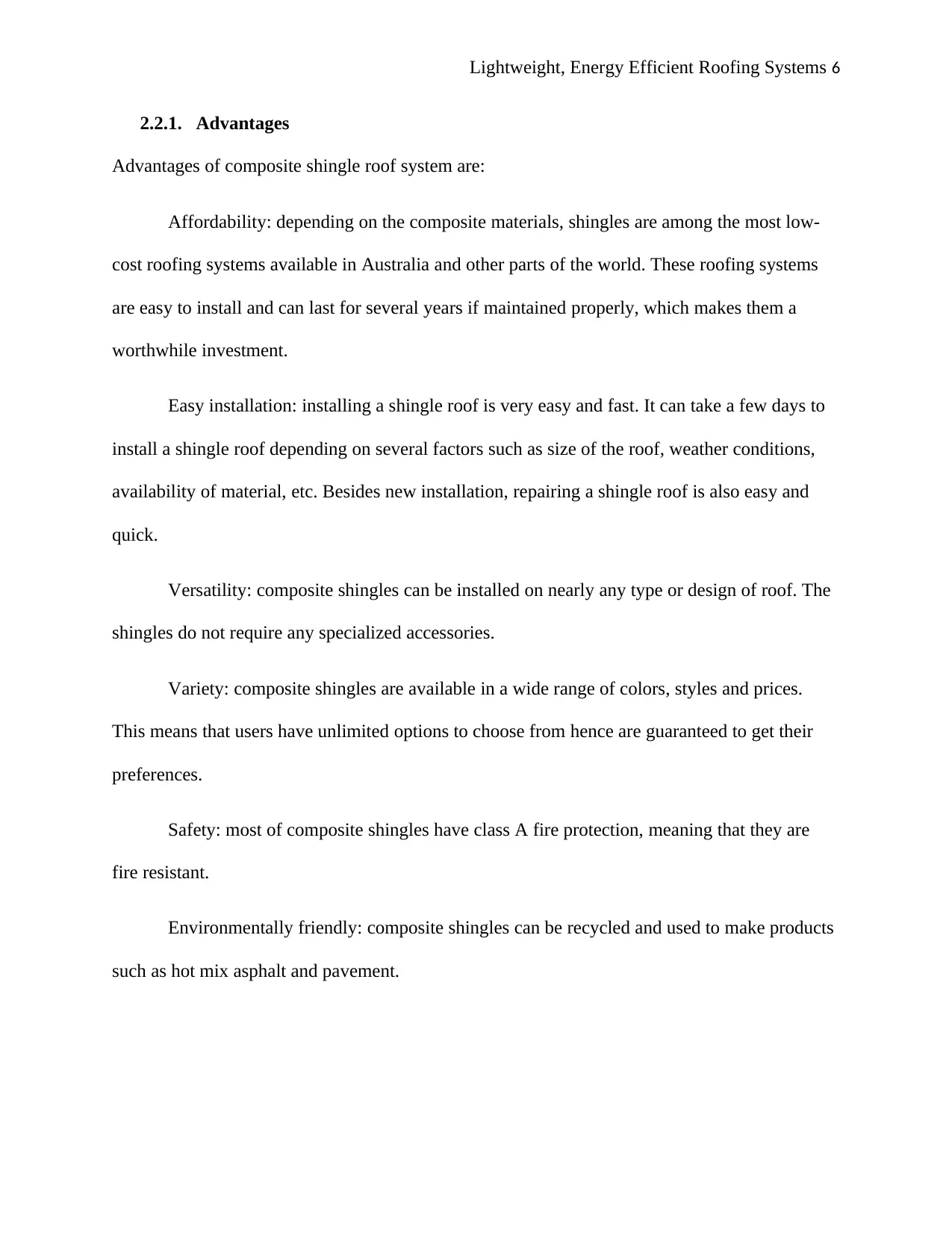
Lightweight, Energy Efficient Roofing Systems 6
2.2.1. Advantages
Advantages of composite shingle roof system are:
Affordability: depending on the composite materials, shingles are among the most low-
cost roofing systems available in Australia and other parts of the world. These roofing systems
are easy to install and can last for several years if maintained properly, which makes them a
worthwhile investment.
Easy installation: installing a shingle roof is very easy and fast. It can take a few days to
install a shingle roof depending on several factors such as size of the roof, weather conditions,
availability of material, etc. Besides new installation, repairing a shingle roof is also easy and
quick.
Versatility: composite shingles can be installed on nearly any type or design of roof. The
shingles do not require any specialized accessories.
Variety: composite shingles are available in a wide range of colors, styles and prices.
This means that users have unlimited options to choose from hence are guaranteed to get their
preferences.
Safety: most of composite shingles have class A fire protection, meaning that they are
fire resistant.
Environmentally friendly: composite shingles can be recycled and used to make products
such as hot mix asphalt and pavement.
2.2.1. Advantages
Advantages of composite shingle roof system are:
Affordability: depending on the composite materials, shingles are among the most low-
cost roofing systems available in Australia and other parts of the world. These roofing systems
are easy to install and can last for several years if maintained properly, which makes them a
worthwhile investment.
Easy installation: installing a shingle roof is very easy and fast. It can take a few days to
install a shingle roof depending on several factors such as size of the roof, weather conditions,
availability of material, etc. Besides new installation, repairing a shingle roof is also easy and
quick.
Versatility: composite shingles can be installed on nearly any type or design of roof. The
shingles do not require any specialized accessories.
Variety: composite shingles are available in a wide range of colors, styles and prices.
This means that users have unlimited options to choose from hence are guaranteed to get their
preferences.
Safety: most of composite shingles have class A fire protection, meaning that they are
fire resistant.
Environmentally friendly: composite shingles can be recycled and used to make products
such as hot mix asphalt and pavement.
⊘ This is a preview!⊘
Do you want full access?
Subscribe today to unlock all pages.

Trusted by 1+ million students worldwide
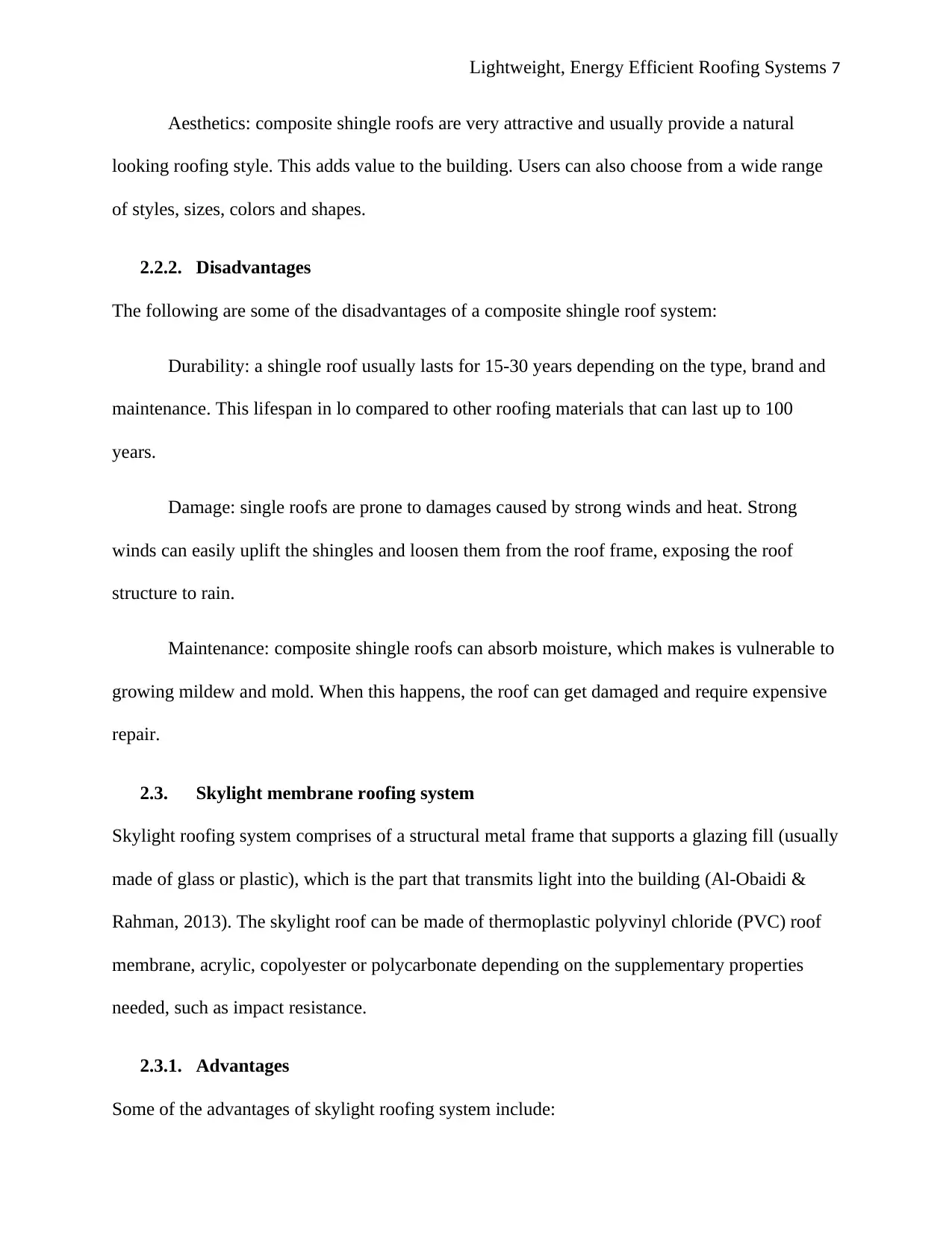
Lightweight, Energy Efficient Roofing Systems 7
Aesthetics: composite shingle roofs are very attractive and usually provide a natural
looking roofing style. This adds value to the building. Users can also choose from a wide range
of styles, sizes, colors and shapes.
2.2.2. Disadvantages
The following are some of the disadvantages of a composite shingle roof system:
Durability: a shingle roof usually lasts for 15-30 years depending on the type, brand and
maintenance. This lifespan in lo compared to other roofing materials that can last up to 100
years.
Damage: single roofs are prone to damages caused by strong winds and heat. Strong
winds can easily uplift the shingles and loosen them from the roof frame, exposing the roof
structure to rain.
Maintenance: composite shingle roofs can absorb moisture, which makes is vulnerable to
growing mildew and mold. When this happens, the roof can get damaged and require expensive
repair.
2.3. Skylight membrane roofing system
Skylight roofing system comprises of a structural metal frame that supports a glazing fill (usually
made of glass or plastic), which is the part that transmits light into the building (Al-Obaidi &
Rahman, 2013). The skylight roof can be made of thermoplastic polyvinyl chloride (PVC) roof
membrane, acrylic, copolyester or polycarbonate depending on the supplementary properties
needed, such as impact resistance.
2.3.1. Advantages
Some of the advantages of skylight roofing system include:
Aesthetics: composite shingle roofs are very attractive and usually provide a natural
looking roofing style. This adds value to the building. Users can also choose from a wide range
of styles, sizes, colors and shapes.
2.2.2. Disadvantages
The following are some of the disadvantages of a composite shingle roof system:
Durability: a shingle roof usually lasts for 15-30 years depending on the type, brand and
maintenance. This lifespan in lo compared to other roofing materials that can last up to 100
years.
Damage: single roofs are prone to damages caused by strong winds and heat. Strong
winds can easily uplift the shingles and loosen them from the roof frame, exposing the roof
structure to rain.
Maintenance: composite shingle roofs can absorb moisture, which makes is vulnerable to
growing mildew and mold. When this happens, the roof can get damaged and require expensive
repair.
2.3. Skylight membrane roofing system
Skylight roofing system comprises of a structural metal frame that supports a glazing fill (usually
made of glass or plastic), which is the part that transmits light into the building (Al-Obaidi &
Rahman, 2013). The skylight roof can be made of thermoplastic polyvinyl chloride (PVC) roof
membrane, acrylic, copolyester or polycarbonate depending on the supplementary properties
needed, such as impact resistance.
2.3.1. Advantages
Some of the advantages of skylight roofing system include:
Paraphrase This Document
Need a fresh take? Get an instant paraphrase of this document with our AI Paraphraser
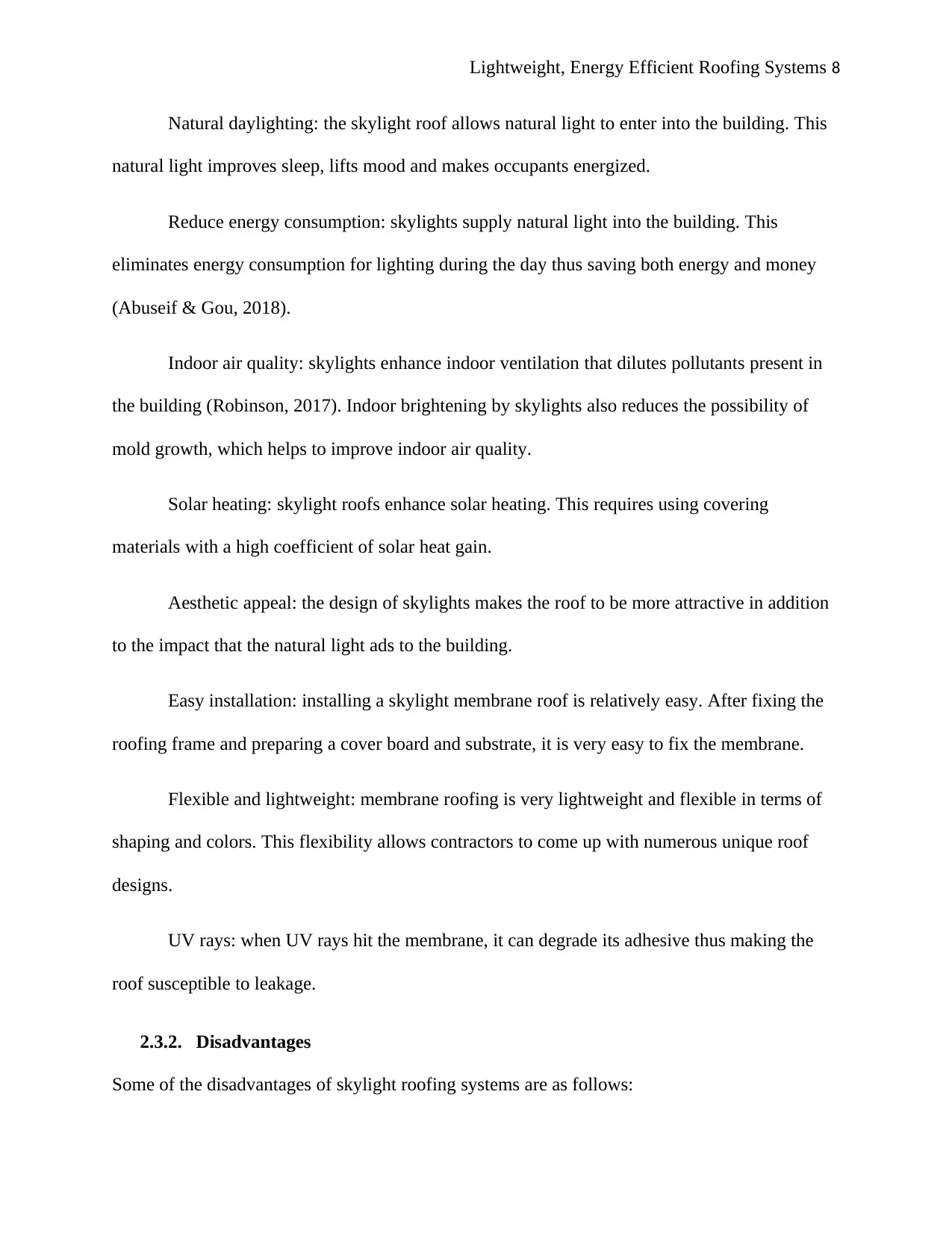
Lightweight, Energy Efficient Roofing Systems 8
Natural daylighting: the skylight roof allows natural light to enter into the building. This
natural light improves sleep, lifts mood and makes occupants energized.
Reduce energy consumption: skylights supply natural light into the building. This
eliminates energy consumption for lighting during the day thus saving both energy and money
(Abuseif & Gou, 2018).
Indoor air quality: skylights enhance indoor ventilation that dilutes pollutants present in
the building (Robinson, 2017). Indoor brightening by skylights also reduces the possibility of
mold growth, which helps to improve indoor air quality.
Solar heating: skylight roofs enhance solar heating. This requires using covering
materials with a high coefficient of solar heat gain.
Aesthetic appeal: the design of skylights makes the roof to be more attractive in addition
to the impact that the natural light ads to the building.
Easy installation: installing a skylight membrane roof is relatively easy. After fixing the
roofing frame and preparing a cover board and substrate, it is very easy to fix the membrane.
Flexible and lightweight: membrane roofing is very lightweight and flexible in terms of
shaping and colors. This flexibility allows contractors to come up with numerous unique roof
designs.
UV rays: when UV rays hit the membrane, it can degrade its adhesive thus making the
roof susceptible to leakage.
2.3.2. Disadvantages
Some of the disadvantages of skylight roofing systems are as follows:
Natural daylighting: the skylight roof allows natural light to enter into the building. This
natural light improves sleep, lifts mood and makes occupants energized.
Reduce energy consumption: skylights supply natural light into the building. This
eliminates energy consumption for lighting during the day thus saving both energy and money
(Abuseif & Gou, 2018).
Indoor air quality: skylights enhance indoor ventilation that dilutes pollutants present in
the building (Robinson, 2017). Indoor brightening by skylights also reduces the possibility of
mold growth, which helps to improve indoor air quality.
Solar heating: skylight roofs enhance solar heating. This requires using covering
materials with a high coefficient of solar heat gain.
Aesthetic appeal: the design of skylights makes the roof to be more attractive in addition
to the impact that the natural light ads to the building.
Easy installation: installing a skylight membrane roof is relatively easy. After fixing the
roofing frame and preparing a cover board and substrate, it is very easy to fix the membrane.
Flexible and lightweight: membrane roofing is very lightweight and flexible in terms of
shaping and colors. This flexibility allows contractors to come up with numerous unique roof
designs.
UV rays: when UV rays hit the membrane, it can degrade its adhesive thus making the
roof susceptible to leakage.
2.3.2. Disadvantages
Some of the disadvantages of skylight roofing systems are as follows:
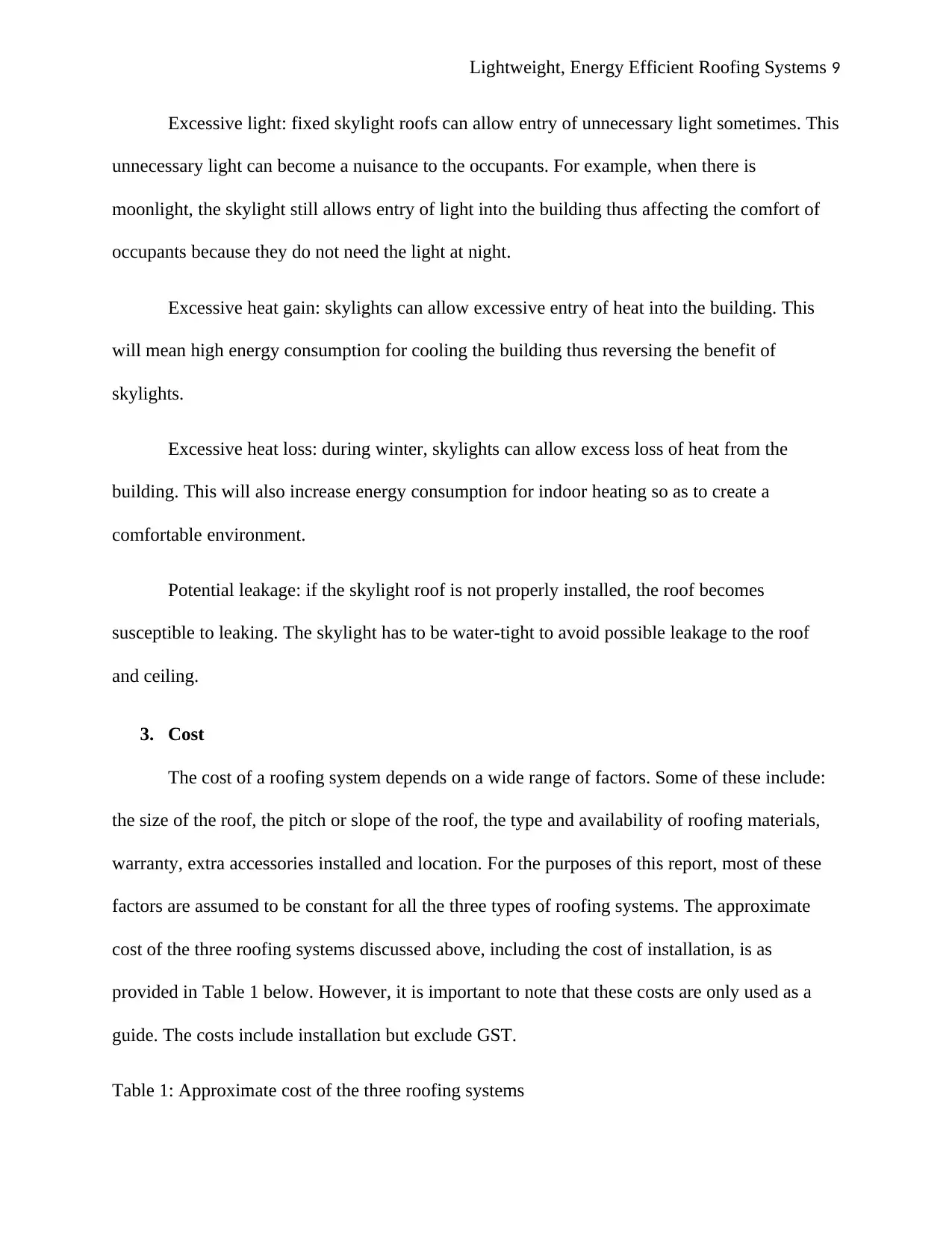
Lightweight, Energy Efficient Roofing Systems 9
Excessive light: fixed skylight roofs can allow entry of unnecessary light sometimes. This
unnecessary light can become a nuisance to the occupants. For example, when there is
moonlight, the skylight still allows entry of light into the building thus affecting the comfort of
occupants because they do not need the light at night.
Excessive heat gain: skylights can allow excessive entry of heat into the building. This
will mean high energy consumption for cooling the building thus reversing the benefit of
skylights.
Excessive heat loss: during winter, skylights can allow excess loss of heat from the
building. This will also increase energy consumption for indoor heating so as to create a
comfortable environment.
Potential leakage: if the skylight roof is not properly installed, the roof becomes
susceptible to leaking. The skylight has to be water-tight to avoid possible leakage to the roof
and ceiling.
3. Cost
The cost of a roofing system depends on a wide range of factors. Some of these include:
the size of the roof, the pitch or slope of the roof, the type and availability of roofing materials,
warranty, extra accessories installed and location. For the purposes of this report, most of these
factors are assumed to be constant for all the three types of roofing systems. The approximate
cost of the three roofing systems discussed above, including the cost of installation, is as
provided in Table 1 below. However, it is important to note that these costs are only used as a
guide. The costs include installation but exclude GST.
Table 1: Approximate cost of the three roofing systems
Excessive light: fixed skylight roofs can allow entry of unnecessary light sometimes. This
unnecessary light can become a nuisance to the occupants. For example, when there is
moonlight, the skylight still allows entry of light into the building thus affecting the comfort of
occupants because they do not need the light at night.
Excessive heat gain: skylights can allow excessive entry of heat into the building. This
will mean high energy consumption for cooling the building thus reversing the benefit of
skylights.
Excessive heat loss: during winter, skylights can allow excess loss of heat from the
building. This will also increase energy consumption for indoor heating so as to create a
comfortable environment.
Potential leakage: if the skylight roof is not properly installed, the roof becomes
susceptible to leaking. The skylight has to be water-tight to avoid possible leakage to the roof
and ceiling.
3. Cost
The cost of a roofing system depends on a wide range of factors. Some of these include:
the size of the roof, the pitch or slope of the roof, the type and availability of roofing materials,
warranty, extra accessories installed and location. For the purposes of this report, most of these
factors are assumed to be constant for all the three types of roofing systems. The approximate
cost of the three roofing systems discussed above, including the cost of installation, is as
provided in Table 1 below. However, it is important to note that these costs are only used as a
guide. The costs include installation but exclude GST.
Table 1: Approximate cost of the three roofing systems
⊘ This is a preview!⊘
Do you want full access?
Subscribe today to unlock all pages.

Trusted by 1+ million students worldwide
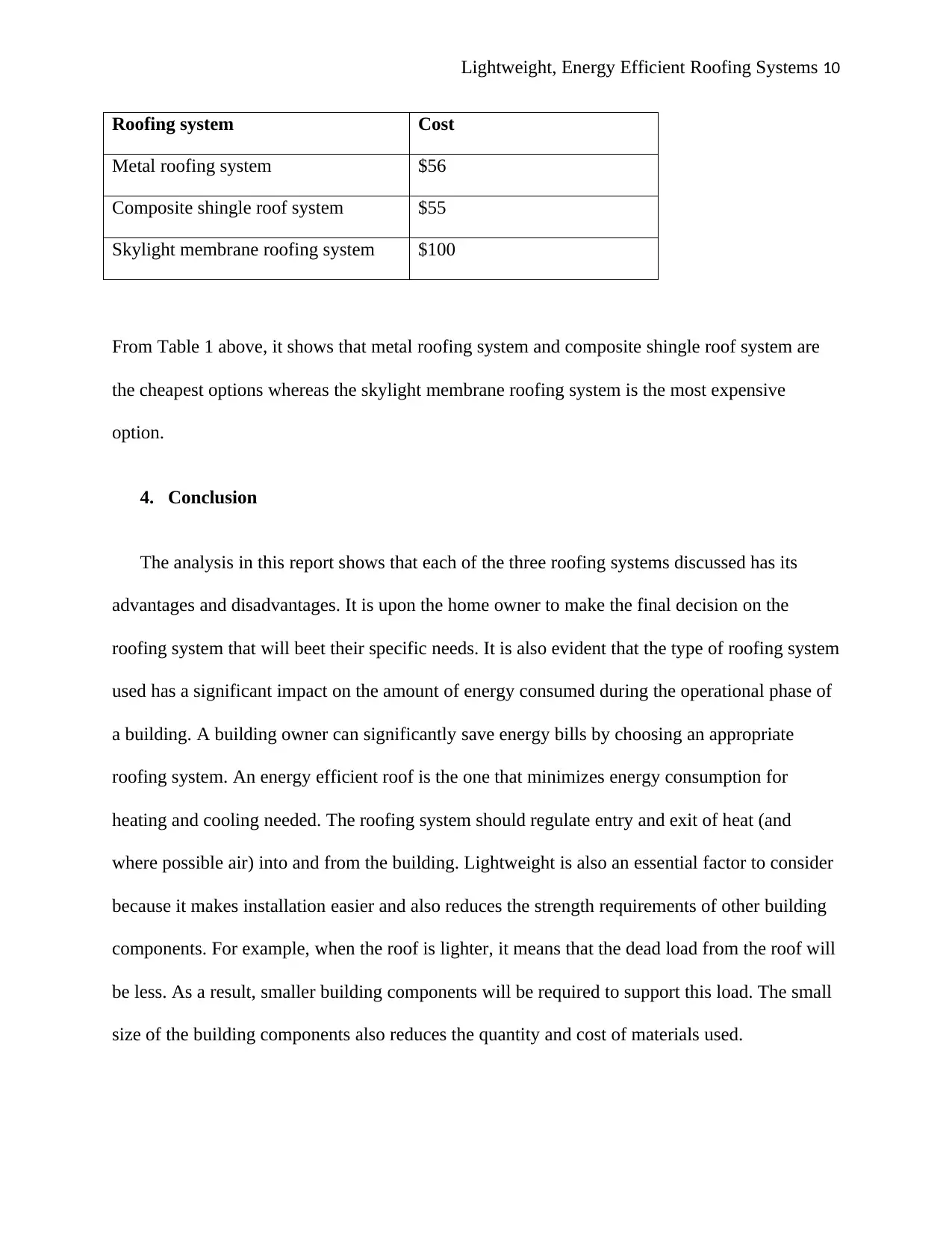
Lightweight, Energy Efficient Roofing Systems 10
Roofing system Cost
Metal roofing system $56
Composite shingle roof system $55
Skylight membrane roofing system $100
From Table 1 above, it shows that metal roofing system and composite shingle roof system are
the cheapest options whereas the skylight membrane roofing system is the most expensive
option.
4. Conclusion
The analysis in this report shows that each of the three roofing systems discussed has its
advantages and disadvantages. It is upon the home owner to make the final decision on the
roofing system that will beet their specific needs. It is also evident that the type of roofing system
used has a significant impact on the amount of energy consumed during the operational phase of
a building. A building owner can significantly save energy bills by choosing an appropriate
roofing system. An energy efficient roof is the one that minimizes energy consumption for
heating and cooling needed. The roofing system should regulate entry and exit of heat (and
where possible air) into and from the building. Lightweight is also an essential factor to consider
because it makes installation easier and also reduces the strength requirements of other building
components. For example, when the roof is lighter, it means that the dead load from the roof will
be less. As a result, smaller building components will be required to support this load. The small
size of the building components also reduces the quantity and cost of materials used.
Roofing system Cost
Metal roofing system $56
Composite shingle roof system $55
Skylight membrane roofing system $100
From Table 1 above, it shows that metal roofing system and composite shingle roof system are
the cheapest options whereas the skylight membrane roofing system is the most expensive
option.
4. Conclusion
The analysis in this report shows that each of the three roofing systems discussed has its
advantages and disadvantages. It is upon the home owner to make the final decision on the
roofing system that will beet their specific needs. It is also evident that the type of roofing system
used has a significant impact on the amount of energy consumed during the operational phase of
a building. A building owner can significantly save energy bills by choosing an appropriate
roofing system. An energy efficient roof is the one that minimizes energy consumption for
heating and cooling needed. The roofing system should regulate entry and exit of heat (and
where possible air) into and from the building. Lightweight is also an essential factor to consider
because it makes installation easier and also reduces the strength requirements of other building
components. For example, when the roof is lighter, it means that the dead load from the roof will
be less. As a result, smaller building components will be required to support this load. The small
size of the building components also reduces the quantity and cost of materials used.
Paraphrase This Document
Need a fresh take? Get an instant paraphrase of this document with our AI Paraphraser
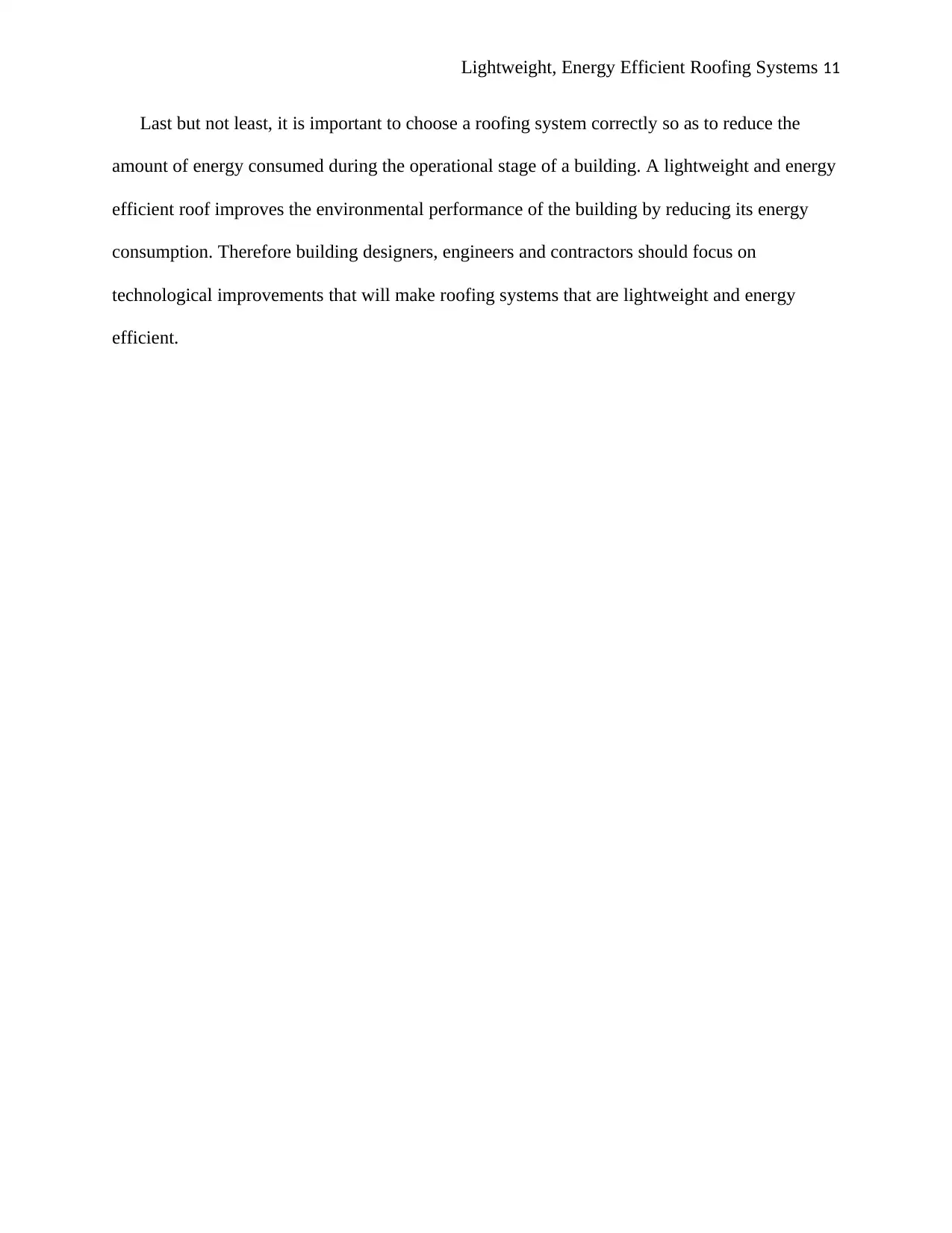
Lightweight, Energy Efficient Roofing Systems 11
Last but not least, it is important to choose a roofing system correctly so as to reduce the
amount of energy consumed during the operational stage of a building. A lightweight and energy
efficient roof improves the environmental performance of the building by reducing its energy
consumption. Therefore building designers, engineers and contractors should focus on
technological improvements that will make roofing systems that are lightweight and energy
efficient.
Last but not least, it is important to choose a roofing system correctly so as to reduce the
amount of energy consumed during the operational stage of a building. A lightweight and energy
efficient roof improves the environmental performance of the building by reducing its energy
consumption. Therefore building designers, engineers and contractors should focus on
technological improvements that will make roofing systems that are lightweight and energy
efficient.
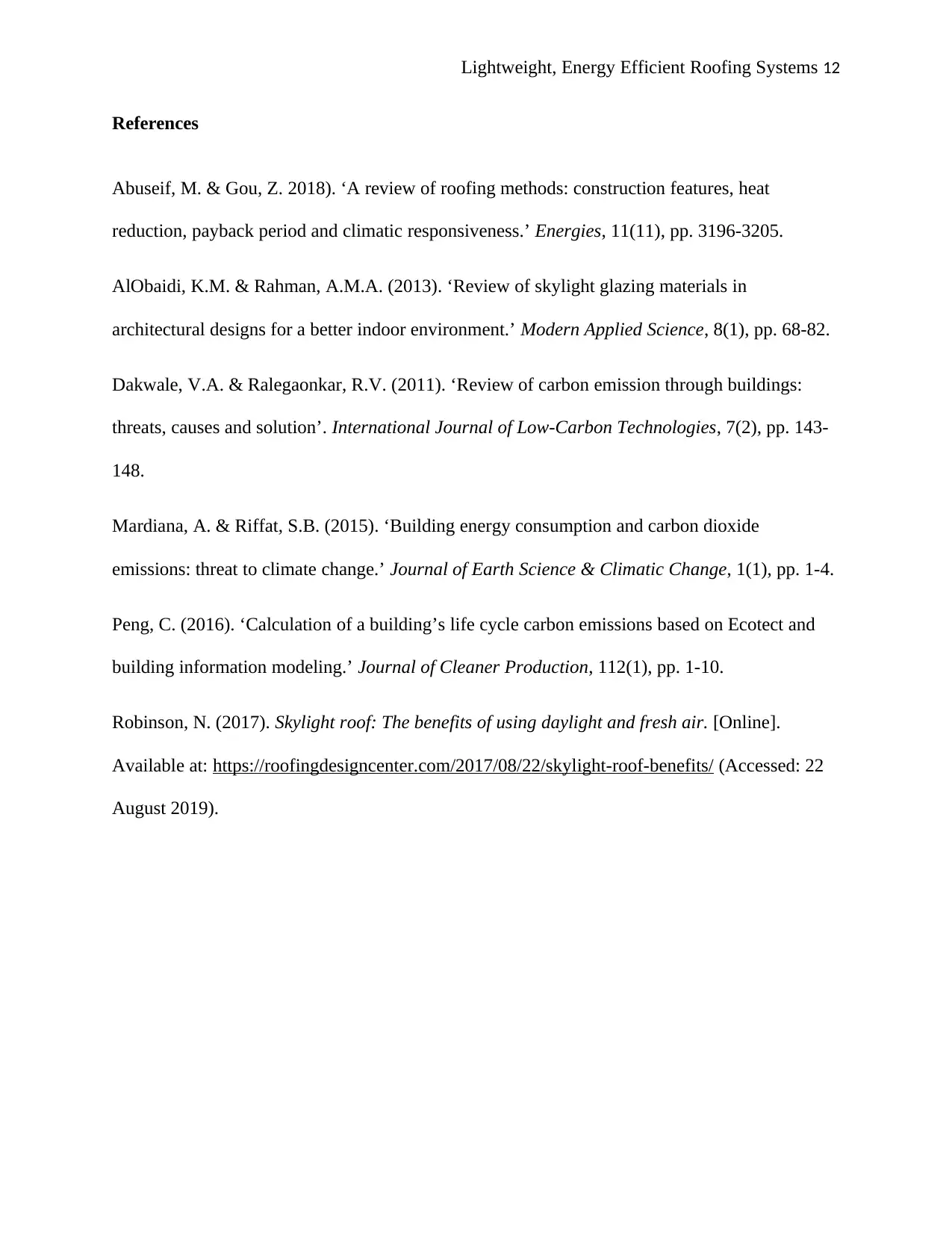
Lightweight, Energy Efficient Roofing Systems 12
References
Abuseif, M. & Gou, Z. 2018). ‘A review of roofing methods: construction features, heat
reduction, payback period and climatic responsiveness.’ Energies, 11(11), pp. 3196-3205.
AlObaidi, K.M. & Rahman, A.M.A. (2013). ‘Review of skylight glazing materials in
architectural designs for a better indoor environment.’ Modern Applied Science, 8(1), pp. 68-82.
Dakwale, V.A. & Ralegaonkar, R.V. (2011). ‘Review of carbon emission through buildings:
threats, causes and solution’. International Journal of Low-Carbon Technologies, 7(2), pp. 143-
148.
Mardiana, A. & Riffat, S.B. (2015). ‘Building energy consumption and carbon dioxide
emissions: threat to climate change.’ Journal of Earth Science & Climatic Change, 1(1), pp. 1-4.
Peng, C. (2016). ‘Calculation of a building’s life cycle carbon emissions based on Ecotect and
building information modeling.’ Journal of Cleaner Production, 112(1), pp. 1-10.
Robinson, N. (2017). Skylight roof: The benefits of using daylight and fresh air. [Online].
Available at: https://roofingdesigncenter.com/2017/08/22/skylight-roof-benefits/ (Accessed: 22
August 2019).
References
Abuseif, M. & Gou, Z. 2018). ‘A review of roofing methods: construction features, heat
reduction, payback period and climatic responsiveness.’ Energies, 11(11), pp. 3196-3205.
AlObaidi, K.M. & Rahman, A.M.A. (2013). ‘Review of skylight glazing materials in
architectural designs for a better indoor environment.’ Modern Applied Science, 8(1), pp. 68-82.
Dakwale, V.A. & Ralegaonkar, R.V. (2011). ‘Review of carbon emission through buildings:
threats, causes and solution’. International Journal of Low-Carbon Technologies, 7(2), pp. 143-
148.
Mardiana, A. & Riffat, S.B. (2015). ‘Building energy consumption and carbon dioxide
emissions: threat to climate change.’ Journal of Earth Science & Climatic Change, 1(1), pp. 1-4.
Peng, C. (2016). ‘Calculation of a building’s life cycle carbon emissions based on Ecotect and
building information modeling.’ Journal of Cleaner Production, 112(1), pp. 1-10.
Robinson, N. (2017). Skylight roof: The benefits of using daylight and fresh air. [Online].
Available at: https://roofingdesigncenter.com/2017/08/22/skylight-roof-benefits/ (Accessed: 22
August 2019).
⊘ This is a preview!⊘
Do you want full access?
Subscribe today to unlock all pages.

Trusted by 1+ million students worldwide
1 out of 12
Related Documents
Your All-in-One AI-Powered Toolkit for Academic Success.
+13062052269
info@desklib.com
Available 24*7 on WhatsApp / Email
![[object Object]](/_next/static/media/star-bottom.7253800d.svg)
Unlock your academic potential
Copyright © 2020–2025 A2Z Services. All Rights Reserved. Developed and managed by ZUCOL.





